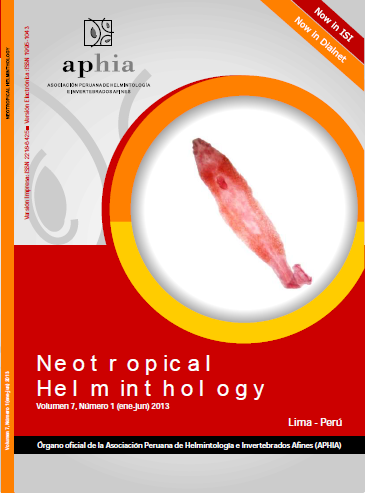PARÁSITOS GASTROINTESTINALES EN PERROS CALLEJEROS DEL CENTRO DE ZOONOSIS DE BOGOTÁ D.C., COLOMBIA
DOI:
https://doi.org/10.24039/rnh201371951Palabras clave:
Ancylostoma caninum, caninos, Isospora canis, parásitos intestinales, prevalencia, Toxocara canis.Resumen
Para determinar la prevalencia de Toxocara canis Werner, 1782 , Ancylostoma caninum Ercolani, 1859 e Isospora canis Meneséri, 1959 en perros callejeros del centro de zoonosis de Bogotá, Colombia, se obtuvieron un total de 70 muestras de materia fecal, colectadas del suelo de cada encierro donde se encontraban los caninos capturados en 11 localidades; un “pool” correspondió a una muestra por localidad, se realizaron tres muestreos seriados y cada muestra se analizó macroscópica y microscópicamente mediante técnicas coprológicas cualitativas y cuantitativas para determinar la presencia de huevos de helmintos u ooquistes. Se encontró una positividad del 88,6% (n= 62) en el total las muestras, donde el 52,9% correspondió a A. caninum, el 7,1% a T. canis, el 24,3% a infecciones mixtas por A. caninum y T. canis, el 1,4% a A. caninum, T. canis e I. canis y el 2,9% a infecciones por A. caninum e I. canis. Las localidades que presentaron el 100% de positividad fueron Usme, Bosa, Chapinero, Ciudad Bolívar y Kennedy. En las otras localidades muestreadas los porcentajes se presentaron entre el 70-80%. Los perros callejeros provenientes de las localidades muestreadas presentaron mono y/o poliparasitismo, dos de los cuales implican un potencial zoonótico (A. caninum y T. canis), lo que representa riesgo de contaminación tanto humana como animal por la eliminación al ambiente de altas cargas parasitarias.
Descargas
Publicado
Cómo citar
Número
Sección
Licencia
Derechos de autor 2021 Neotropical Helminthology

Esta obra está bajo una licencia internacional Creative Commons Atribución-NoComercial-SinDerivadas 4.0.
OBJETO: El AUTOR-CEDENTE transfiere de manera TOTAL Y SIN LIMITACIÓN alguna al CESIONARIO los derechos patrimoniales que le corresponden sobre la (s) obra(s) tituladas: xxxxxxxxxxxxxxxx, por el tiempo que establezca la ley internacional. En virtud de lo anterior, se entiende que el CESIONARIO adquiere el derecho de reproducción en todas sus modalidades, incluso para inclusión audiovisual; el derecho de transformación o adaptación, comunicación pública, traducción, distribución y, en general, cualquier tipo de explotación que de las obras se pueda realizar por cualquier medio conocido o por conocer en el territorio nacional o internacional.
REMUNERACIÓN: La cesión de los derechos patrimoniales de autor que mediante este contrato se hace será a título gratuito.
CONDICIONES Y LEGITIMIDAD DE LOS DERECHOS: El AUTOR-CEDENTE garantiza que es propietario integral de los derechos de explotación de la(s) obra(s) y en consecuencia garantiza que puede contratar y transferir los derechos aquí cedidos sin ningún tipo de limitación por no tener ningún tipo de gravamen, limitación o disposición. En todo caso, responderá por cualquier reclamo que en materia de derecho de autor se pueda presentar, exonerando de cualquier responsabilidad al CESIONARIO.
LICENCIA DE ACCESO ABIERTO: El AUTOR-CEDENTE autoriza que manuscrito publicado en La Revista Neotropical Helminthology permanece disponible para su consulta pública en el sitio web https://www.neotropicalhelminthology.com/ y en los diferentes sistemas de indexación y bases de datos en las que la revista tiene visibilidad, bajo la licencia Creative Commons, en la modalidad Reconocimiento-No comercial- Sin Trabajos derivados –aprobada en Perú, y por lo tanto son de acceso abierto. De ahí que los autores dan, sin derecho a retribución económica, a la Asociación Peruana de Helmintología e Invertebrados Afines (APHIA), los derechos de autor para la edición y reproducción a través de diferentes medios de difusión.


 Numero 2 Volumen 19 - 2025 (versión Anticipada)
Numero 2 Volumen 19 - 2025 (versión Anticipada)














































